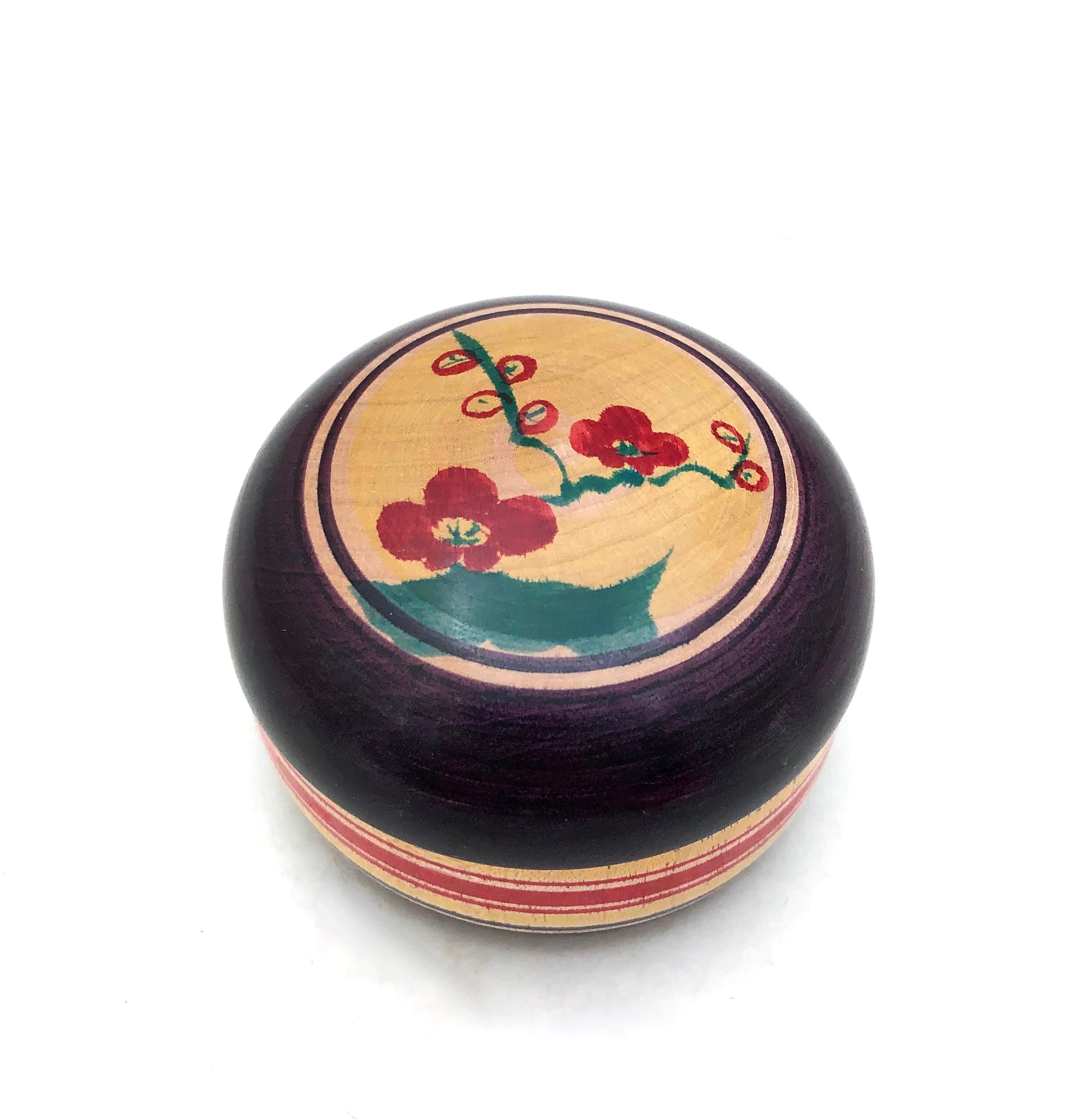
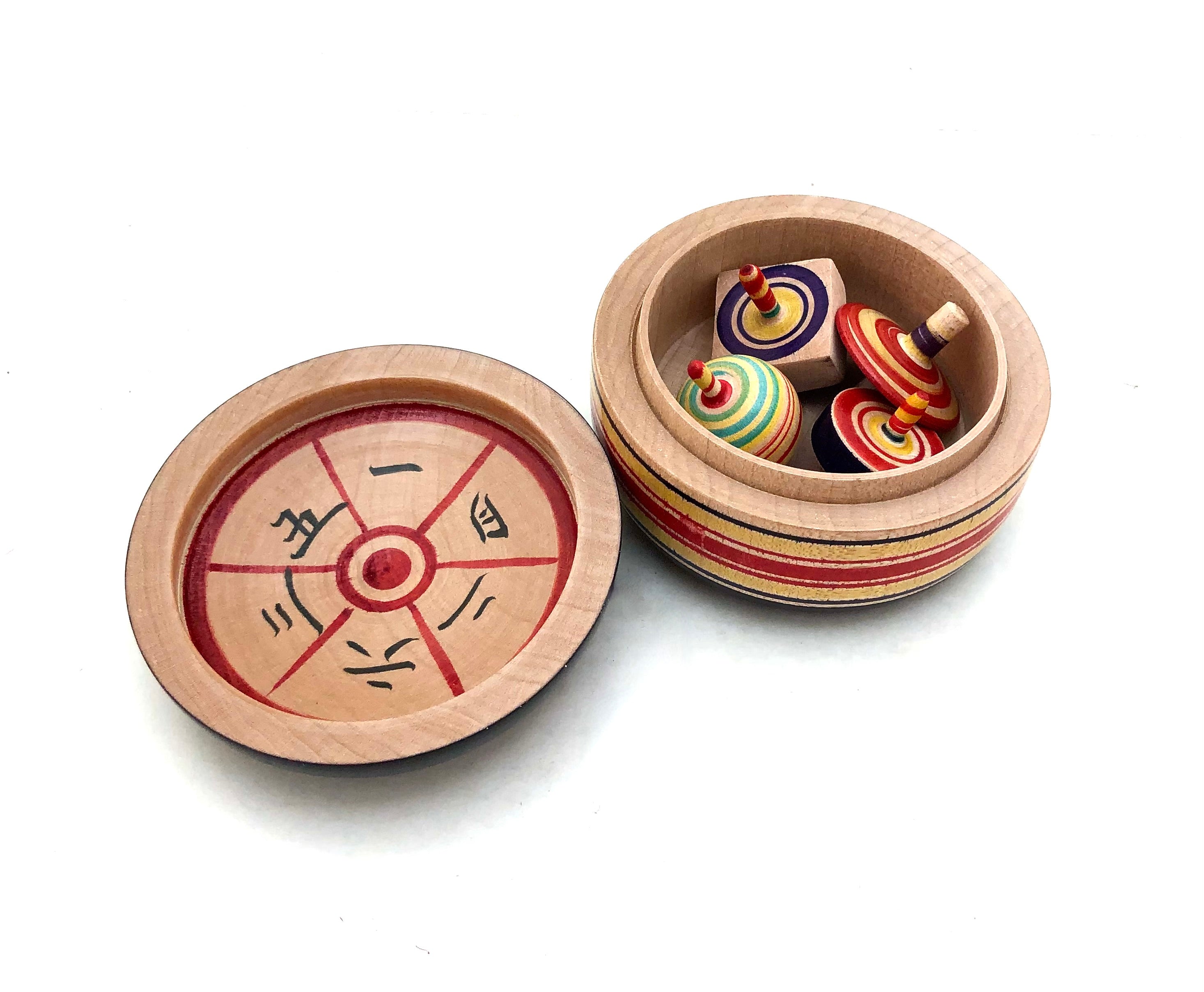
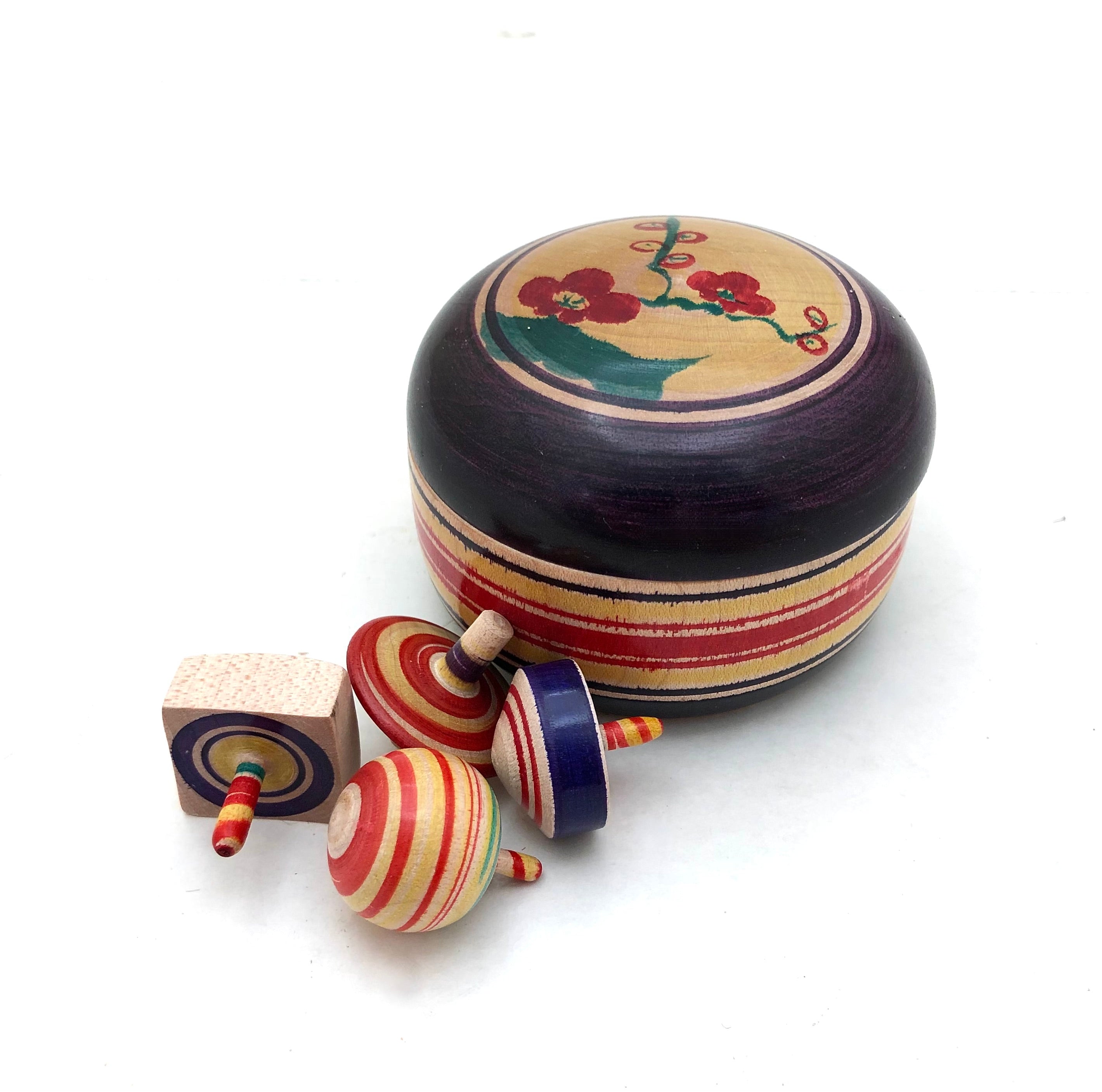
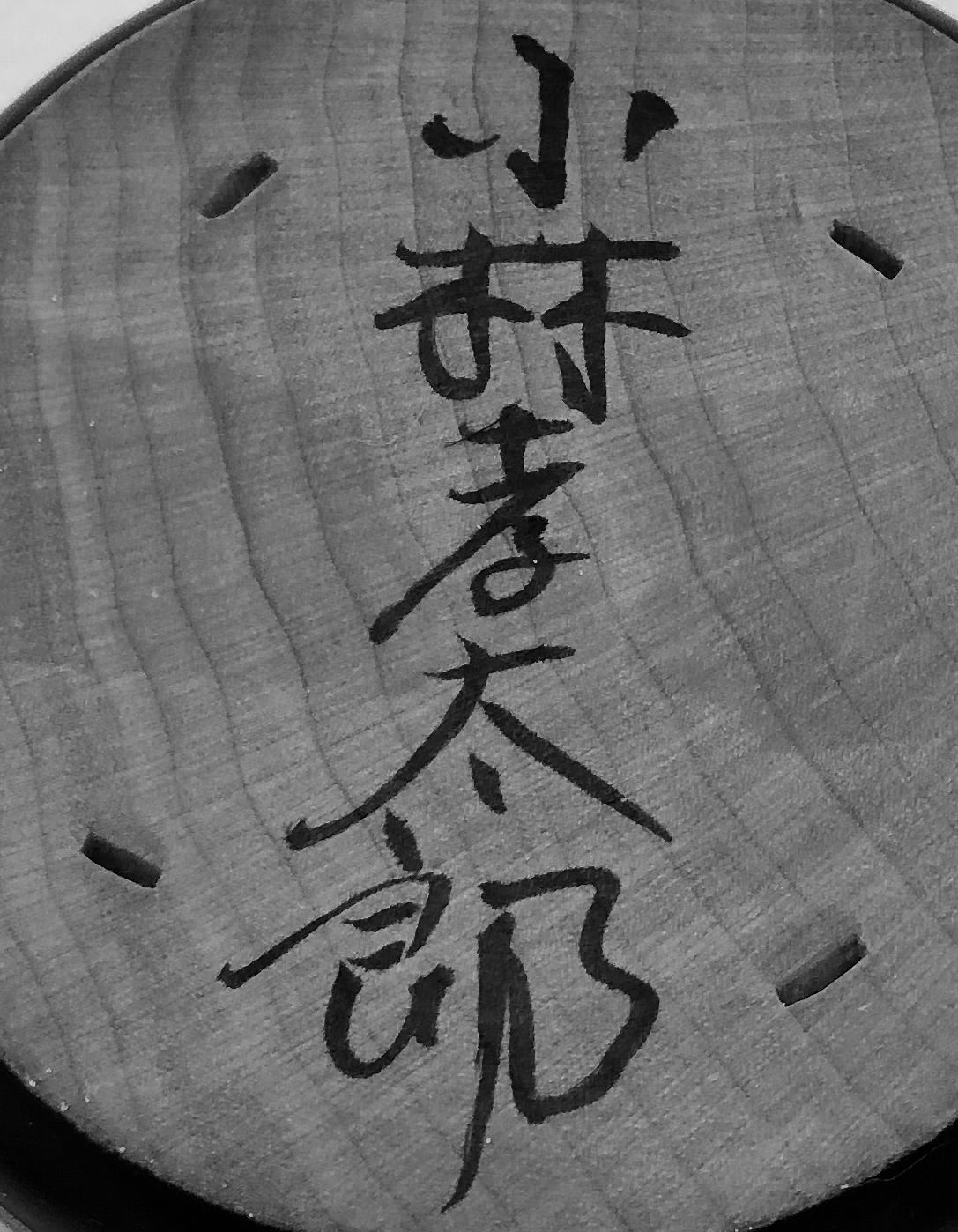
Vintage Japanese Yamagata/Sakunami Wooden Koma Container | Rare Fortune Telling Container by Kobayashi, Kotaro
Dimensions: 2-0”h x 2-3/4”dia.
One rarely seen this type of original Kokeshi inspired vintage Japanese wooden toy made by Kobayashi Kotaro (b. 1936), a Sakunami carver who specialize in this subject matter. This family of creators hail from Miyagi Prefecture.
This style of container for spinning tops is painted in a veritable rainbow of colors in red yellow and purple, and all made to attract older children in the 1950s. The sides of the toy is incorporates Rokoru mono stripes running around the container. When the lid is removed there are marking in sections on the inside related to telling fortunes, (uranai) containing four wonderful, scaled spinning tops. Each top is differently that serve as options for a player to choose from. The entire piece possesses the warm-heartedness of being a true treasure of a particular time in history. The base of the container is made of Mazuki, which is a very pale, fine, white-grained variety of dogwood, which is native to the area. It has the artists script signature on the bottom of the container.
See our Vintage Japanese Toy Section: https://mingeiarts.com/collections/vintage-japanese-toys as well as our e-book entitled: A Collector’s Guide: Traditional and Creative Kokeshi and Toys: https://mingeiarts.com/collections/our-books/products/a-collectors-guide-traditional-and-creative-kokeshi-and-toys
Condition: Excellent meaning that the piece retains its original craft/workmanship and functions as intended, showing a wonderful-developed patina and is void of damage, cracks, breakage, or repairs and meets all the standards of the collectible Vintage Traditional Kokeshi Toys.
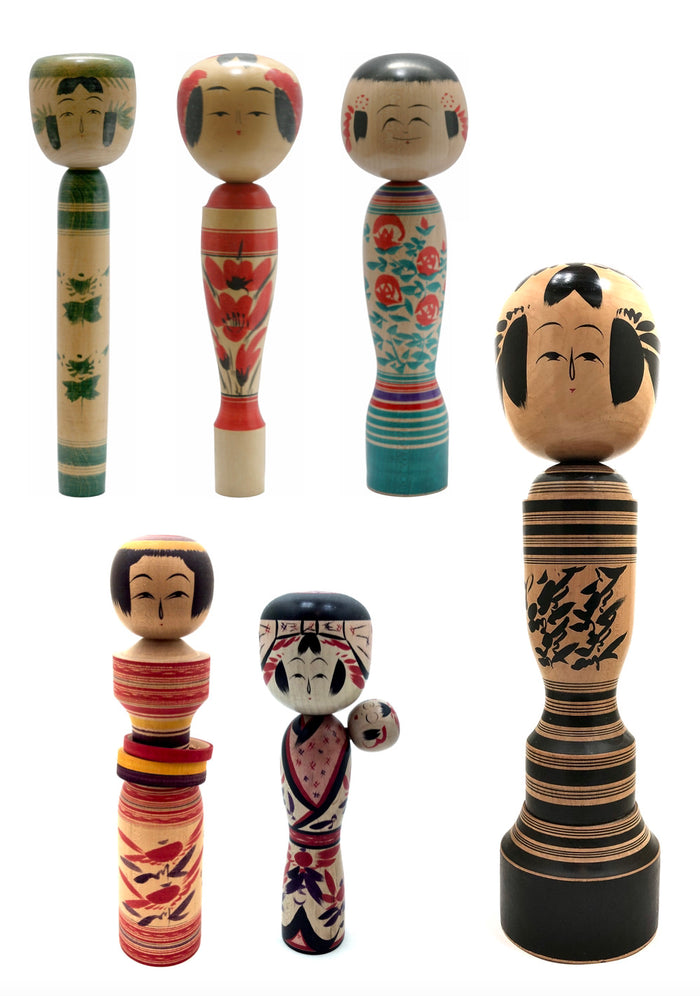
Japanese Traditional Kokeshi
Yamagata-Sakunami-Kei (Family)
Prefecture: Miyagi
Origin:
Unique to this strain of the original ten traditional types is the fact that the Yamagata Kokeshi originated at Sakunami Onsen in Miyagi Prefecture, and was produced by the Kobayashi family. The family later moved to the city of Yamagata in the prefecture of the same name. However, the Hiraga family stayed in Sakunami and continued producing the same style doll, which is why these Kokeshi are made in two different locations. Because there are two very different body shapes in this group, many people consider them separately, but due to the confusion over who actually created the first of this type, we will discuss them as one family.
Collector's note – characteristics/painting style:
The dolls have disproportionately larger heads, but while the Yamagata doll has a very slender body, the later Sakunami dolls have wide upper bodies, and very narrow bases. Both look quite top-heavy, leading some people to assume that originally they were much smaller, and designed to be hand-held toys, rather than freestanding dolls. Both strains are made of one piece of wood with faces that incorporate two lidded eyes as well as a single-lid on top of the eye. The mouth is usually two short parallel lines, with some having a red line with a red dot below. Plum, (Ume), and crab-flower chrysanthemum, (Kiku), blossoms dominate the body design. Additionallly, Safflowers are seen, and are considered unique to this strain. The flowers are usually painted in a very bold, stylized design in colours of red and dark green, and also painted or grooved bands ringing the top and the bottom of the dolls. The hair is pulled nto a single “braid” that is t ied with a circular red ribbon with radiating ends. Some dolls have hats similar to the conical (Suge-gasa) hat that incorporates “chattering” rather than painting giving them texture. Most have traditional half-moon shaped bangs and tufts, or side hair fringes framing the face. Indeed, these dolls are one of the older Kokeshi forms, as they date to the early Meiji period, (1868-1912). A final unique feature of the Sakunami dolls is the fact they are only made from Mizuki, a very pale, fine-grained variety of dogwood, which grows in the Yamagata area.

Leading, Craftsmen:
Abe, Masayoshi, 1939- No additional published information
Hayashaka, Dinkichi - No additional published information
Higara, Teizo, 1897-1992 - No additional published information
Hiraga Tadashi, b. 1937, (Sakunami, Miyagi) - Masters: Hiraga Kenjiro, 1918, (Sakunami, Miyagi) - Master: Hiraga, Kenjiro, 1918-2012 - No additional published information
Hirose, Shigeo, 1926, (Mikura-jima, Tokyo) - Master Suzuki, Shoji. No additional published information
Kobayashi, Koutaro, 1936, (Yamagata) - Master: Kobayashi, Eizo. No additional published information
Kobayashi, Eizo, Master, 1907 (Yamagata) - Masters: Koyabashi, Kuraki-chi and Kobayashi, Seizo - No additional published information
Kobayashi, Seitaro, Grand Master, 1926-2005, (Yamagata) - Master: Kobayashi. No additional published information
Kobayashi, Seijiro, 1918-2015 - No additional published information
Okuyama, Kozo, 1905-1984, (Kahoku, Yamagata) - Master: Okuyama, Yasuji. No additional published information
Shida, Kikumaro, 1892-1984 - No additional published information
Satomi, Masao, 1922-1981 - No additional published information
Shido, Shozan, 1932-1995. No additional published information
Umezu, Haruo, 1926, (Yamagata) - Master Kanayama, Buntaro. No additional published information
Explore & Learn More about Yamagata-Sakunami-Kei (Family)